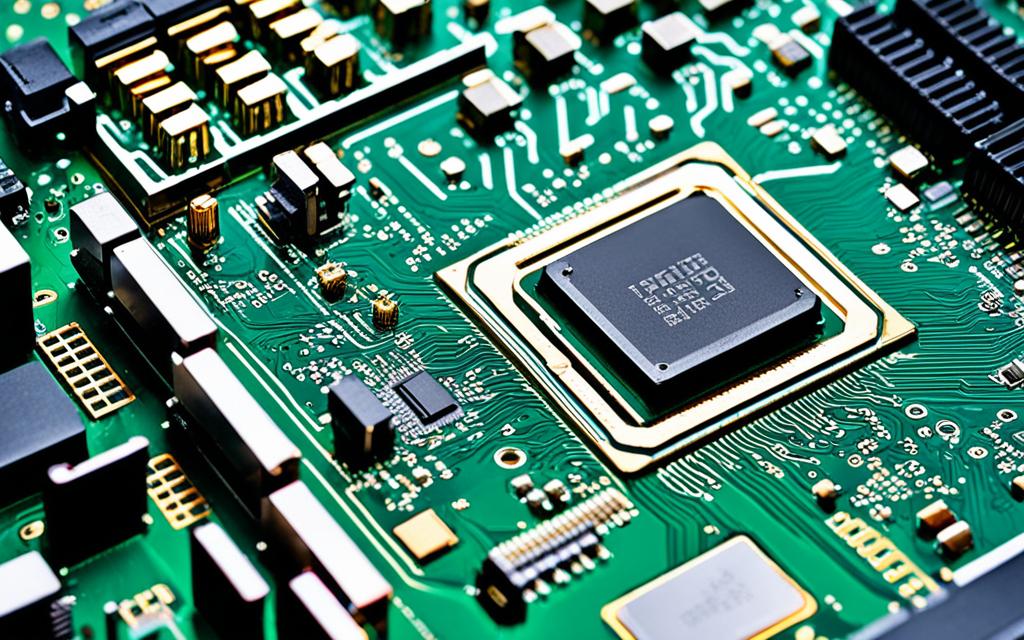Table of Contents
Adding a new graphics card to an old PC is exciting. It makes your computer feel brand new and boosts your games or graphic design work. Wondering which graphics card fits your PC? We’re here to help.
If you’ve got a PC that’s less than ten years old, good news! You can easily use cutting-edge graphics cards like the Nvidia RTX 2080 Ti or the AMD Radeon RX 5700 XT. Thanks to PCI Express technology, these fancy cards work even on motherboards from as far back as when George W. Bush was president1. Still, there are some things you need to check to upgrade successfully.
Key Takeaways:
- Modern graphics cards can work with PCs built in the last ten years1.
- PCI Express tech means you can add high-end cards to older boards1.
- Check if you have a PCIe x16 slot available1.
- Make sure there’s enough room in your case for the new card1.
- Check if your CPU and RAM can support the new graphics card1.
Do You Have PCIe x16?
In the world of graphics cards, the PCIe x16 slot is crucial. It allows the graphics card to connect with your motherboard. This lets the card work at its best.
The PCIe x16 slot offers a fast connection for graphics cards. It moves data quickly and efficiently, boosting performance. This makes it perfect for gaming and demanding tasks.
Wondering if your PC has a PCIe x16 slot? Don’t worry. PCIe is known for its backward compatibility. This means newer graphics cards can fit into older motherboards. There are three types of PCIe x16 slots: PCIe 1.0a/1.1, PCIe 2.0, and PCIe 3.0. They all work with each other, thanks to backward compatibility2.
However, graphics cards differ in size and power needs. The bigger ones might need extra space and have power sockets at the back. Keep this in mind when you check if a card will fit in your PC case2.
Also, consider your PC’s power supply unit (PSU) when upgrading. High-end graphics cards might need a 600W PSU. It’s advisable to use only up to 80% of your PSU’s maximum capability2. The right PSU wattage changes with different GPU connectors. It can range from 350W for a simple 6-pin connector to 750W for two 8-pin connectors1. Make sure your older PC’s system, like the CPU and RAM, can support the upgrade1.
If you’re planning to upgrade, check for a PCIe x16 slot first. It’s essential for top performance. PCIe x16 slots are great because they accept old and new cards. This opens up a world of amazing graphics and games.
Overview of PCIe x16 Versions and Backward Compatibility
| PCIe Version | Max Bandwidth | Backward Compatibility |
|---|---|---|
| PCIe 1.0a/1.1 | 250 MB/s | Compatible with PCIe 2.0 and PCIe 3.0 cards |
| PCIe 2.0 | 500 MB/s | Compatible with PCIe 3.0 cards |
| PCIe 3.0 | 1 GB/s | Compatible with PCIe 4.0 cards |
Source:2
How Much Space in Your Case?
When choosing a graphics card for your PC, think about how much space you have. The size of your case affects which graphics card will fit. Measure the space from the expansion slots to any parts that might be in the way, like drive bays or fans. This tells you the biggest size of the graphics card your case can take3.
Also, look at where the PCIe power connectors on the graphics card are. These connectors power the graphics card. Their position can change depending on the model of the GPU3.
Pick a graphics card with a bit of extra room to spare. This helps with airflow and fitting it in without trouble. Such space is key for cooling and keeping your GPU running well3.
Compact PCs have their own set of rules regarding graphics card size. Cases like mini-ITX are small and have tight limits on GPU size. Check your case’s maximum GPU length if you own a compact PC3.
To figure out your case’s space and the longest GPU it can hold, look at the manufacturer’s details or use PCPartPicker. These resources can guide you to a compatible graphics card. [source]
Frequently Asked Questions
- What happens if the graphics card is too long for my case?
- Can I modify my case to fit a larger graphics card?
- Are there any alternative solutions if my case doesn’t have enough clearance?
- Is GPU length the only consideration for graphics card compatibility?
If the graphics card is too big, it won’t fit right or could hit other parts. Making sure your graphics card fits your case is key3.
Changing your case for a bigger graphics card is usually a bad idea. It can cancel warranties and harm your case or parts. It’s smarter to pick a graphics card that suits your case3.
If your case is too small, think about getting a bigger one. Or look at smaller graphics cards designed for tight spaces3.
GPU length matters, but it’s not all you should think about. Consider your power supply, expansion slots, and case airflow too. All these ensure your gaming setup works well3.
Do You Have the Right PSU?
When upgrading or building your PC, the power supply (PSU) is key but often forgotten. It ensures all your PC’s parts get steady and reliable power. This is essential for your computer to work well.
It’s important to check if your current PSU meets your needs. The wattage of the PSU shows how much power it can give your components.
Looking at advice, we see the Lenovo Idea Centre 3 usually has a 180W or 240W PSU4. That might not be enough for adding a powerful graphics card.
High-end graphics cards for gaming need more power than the motherboard offers. PEG connectors give the graphics card this extra power. PEG stands for PCI Express Graphics.
When choosing a graphics card, make sure your PSU has the needed PEG connectors. The card’s specs will show the recommended PSU wattage5. It’s vital to pick a PSU with enough wattage and connectors for your GPU.
A PSU with more wattage than you currently need is a good choice. It gives room for future upgrades and improves stability and efficiency5.
PSU efficiency is another key factor. It shows how well a PSU changes AC from the wall into DC for your parts. Efficient PSUs waste less power and produce less heat. This can help your components last longer. PSUs with an 80 Plus rating are at least 80% efficient and are advisable5.
Highly efficient PSUs not just save power and make less heat but often include extra features. They may have fans that run only when necessary or liquid cooling systems5.
When buying a PSU, consider its form factor and if it’s modular. There are different sizes, like ATX for most and SFX or CFX for small PCs. It’s essential to ensure the PSU fits your case to prevent issues5.
Recommendations point to the MSI GeForce GTX 1050 Ti 4GB LP for gaming and fitting the Lenovo Idea Centre 34. Another option could be the GTX1650, if you’re within a €250 budget4.
Thinking about PSU wattage, PEG connectors, efficiency, and form factor ensures you pick the right PSU. A well-chosen PSU reaches best efficiency at 40-60% of its max output.
| Power Supply Factors | Consideruizations |
|---|---|
| Power Supply Wattage | Check if it meets your system requirements and the recommended wattage of your graphics card45. |
| PEG Connectors | Ensure your PSU has the necessary PEG connectors for your graphics card. |
| PSU Efficiency | Opt for a power supply with high efficiency, such as those with an 80 Plus rating5. |
| Form Factor | Verify that the power supply’s size and form factor are compatible with your PC case5. |
| Modularity | Consider whether a modular or non-modular power supply suits your cable management needs and airflow preferences. |
Source Links
- https://www.tomshardware.com/features/graphics-card-compatibility – What Graphics Cards Are Compatible With My PC?
- https://www.techadvisor.com/article/727180/how-to-know-if-a-graphics-card-is-compatible.html – How to know if a graphics card is compatible
- https://www.hp.com/us-en/shop/tech-takes/gpu-buying-guide – GPU Buying Guide: How To Choose the Right Graphics Card | HP® Tech Takes
- https://forums.tomshardware.com/threads/what-graphics-card-is-compatible-with-my-pc.3735857/ – [SOLVED] – What graphics card is compatible with my PC?
- https://www.intel.com/content/www/us/en/gaming/resources/power-supply.html – How to Choose Power Supply for PC: What to Know – Intel
- https://www.pcguide.com/gpu/what-gpu-can-my-motherboard-support/ – What GPU can my motherboard support?
- https://www.linkedin.com/pulse/how-select-right-gpu-your-requirement- – How to select the right GPU for your requirement?








